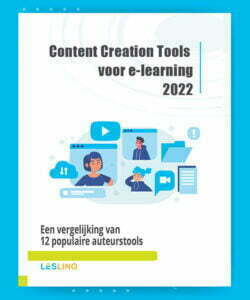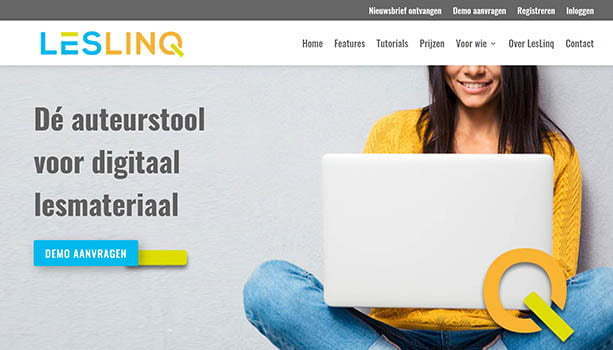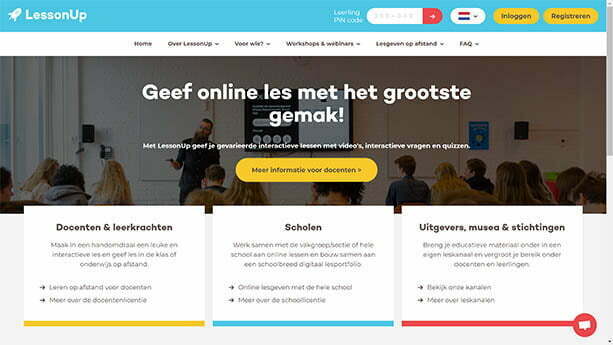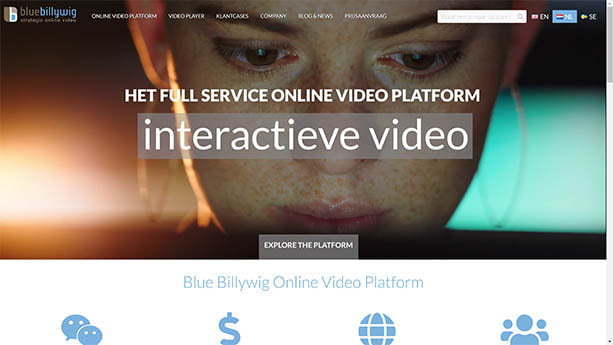Auteurstools voor het maken van digitaal lesmateriaal in 2021
Een vergelijking van 5 populaire auteurstools
E-learning maakt een enorme groei door. Daarmee is ook de vraag naar professionele tools voor het maken van interactief lesmateriaal toegenomen. Steeds meer educatieve uitgevers zoeken een professionele auteurstool om lesmateriaal interactief te maken en / of interactieve video toe te voegen. Auteurstools zijn er echter in alle soorten en maten. Hoe weet je welke auteurstool het beste past bij jouw organisatie? Waar moet je op letten bij het kiezen van een auteurstool? In dit artikel vergelijken we 5 populaire auteurstools voor het maken van digitaal lesmateriaal. We richten ons op educatieve uitgevers.
Wat is een auteurstool eigenlijk?
Een auteurstool is een online editor waarmee je eigen lesmateriaal aanmaakt. Auteurstools worden gebruikt om kleine stukjes informatie zoals tekst, afbeeldingen, audio, video, etc. samen te voegen tot digitaal lesmateriaal. Het lesmateriaal dat je hiermee maakt, kan je eenvoudig koppelen aan een digitale leeromgeving. Als gebruiker heb je geen technische programmeerkennis nodig om een auteurstool voor e-learning te gebruiken. Een goede auteurstool is namelijk zo ingericht dat de interface begrijpelijk is en dat je elementen kunt samenvoegen en interactief kunt maken, zonder dat hier uitgebreide technische kennis voor nodig is.
Verschillende soorten auteurstools
De belangrijkste functie van een auteurstool is het maken van digitaal lesmateriaal voor e-learning. Toch zijn er veel verschillen soorten auteurstools. De een richt zich op video en interactie, de ander op gemak, een derde heeft zich gespecialiseerd in toetsing… Elke tool heeft haar eigen voor- en nadelen. Om je te helpen met de keuze voor een auteurstool voor e-learning hebben we 5 populaire auteurstools op een rijtje gezet en met elkaar vergeleken op hoofdlijnen.
De eigenschappen waarop wij de verschillende auteurstools vergeleken
- Functionaliteit
- Mate van interactiviteit
- Gebruiksgemak
- Import/export mogelijkheden
- Prijs
Auteurstools 2021: deze 5 tools vergeleken we
1. LesLinq
Algemene info
LesLinq is een vrij nieuwe auteurstool voor het maken van digitaal lesmateriaal. De tool is gericht op educatieve uitgevers die interactief digitaal lesmateriaal willen maken. Ook al is de tool vrij nieuw, het is ontwikkeld door Grafi Offshore, een bedrijf dat al bijna 15 jaar actief is in de productie van digitaal lesmateriaal en het bouwen van Leerlingmanagementsystemen voor uitgevers.
Voordeel aan LesLinq is dat product development erg snel gaat: er worden wekelijks nieuwe mogelijkheden toegevoegd, zoals uitgebreidere video-interactie mogelijkheden, animatie, toetsing en templates.
Functionaliteit
LesLinq is een online auteurstool met uitgebreide functionaliteiten. Een belangrijk kenmerk is het open canvas dat je kunt inrichten zoals je wilt. Het is mogelijk om tekst, afbeeldingen, buttons, vormen, video en audio toe te voegen. Ook is het mogelijk om eigen audio en video op te nemen in LesLinq. De tool is gekoppeld aan de beeldbank Unsplash, zodat de gebruiker naast eigen materiaal ook een ruime keuze aan extern beeldmateriaal heeft. LesLinq beschikt over een ‘collaborate’ functie om samen te werken aan digitaal lesmateriaal.
Mate van interactiviteit
LesLinq biedt bijzonder veel mogelijkheden om interactiviteit toe te voegen. Aan elk element dat je toevoegt aan het open canvas kan je een of meerdere ‘actions’ koppelen.
Soorten actions die kunnen worden gebruikt zijn:
- Open URL
- Go to page
- Change property
- Change style
- Animate
- Play / stop audio
- Play / stop video
Aan elk los element kan je aparte stylingelementen koppelen, zoals kleur of transparantie. Faden, zoomen, slide in… In combinatie met de Actions zijn de mogelijkheden om elementen interactief te maken eindeloos.
Gebruiksgemak
LesLinq is eenvoudig in gebruik, de leercurve is laag. Technische kennis is niet nodig om in korte tijd een volledige interactieve les te maken. Groot voordeel van LesLinq is dat het recenter is ontwikkeled met nieuwere technologie en niet de ‘legacy’ meedraagt waar oudere tools last van kunnen hebben. Wil je alleen simpele, standaard lessen kunnen ontwikkelen? Vergeleken met andere tools heeft LesLinq nog minder standaard templates beschikbaar. Omdat LesLinq nog wat korter meedraait, is de database van templates nog volop in ontwikkeling. Wel is er de mogelijkheid om voorontwikkelde interactiesets, zoals tijdlijnen en kaarten met hotspots, in je les te zetten en deze aan te passen aan de stijl van de methode/cursus.
Import/export mogelijkheden
LesLinq biedt de mogelijkheid om diverse bestandsformaten, zoals Powerpoint, PDF, Illustrator, InDesign en Photoshop, te importeren en verder te bewerken in LesLinq. Lessen kunnen gedeeld worden via een online link, maar het is ook mogelijk om lesmateriaal te downloaden als HTML5 bestand. Daarnaast is het mogelijk om LesLinq op maat te integreren met elk gewenst LMS.
2. LessonUp
Algemene info
LessonUp is een online auteurstool waarmee leerkrachten gevarieerde interactieve lessen kunnen maken met video, afbeeldingen, interactieve vragen en quizzen. De tool kenmerkt zich door een grote hoeveelheid kant-en-klaar lesmateriaal dat ook weer hergebruikt kan worden. Alle lessen die in LessonUp ontwikkeld worden zijn ‘open’. Leraren kunnen kennis heel gemakkelijk delen en zich door elkaar laten inspireren. LessonUp werkt met vaste templates en is zeer eenvoudig in gebruik. Dit maakt het voor leraren heel eenvoudig om een digitale les ontwikkelen. Voor uitgevers biedt LessonUp de mogelijkheid om lessen aan te bieden via een vast kanaal.
Functionaliteit
Het programma verzamelt alle filmpjes, quizzes en overige informatie over een onderwerp of les en giet dit in een aantrekkelijk jasje. Wanneer je een nieuwe les aanmaakt, kan je kiezen uit een slide, video, afbeelding, website, Google Map, Powerpoint. Ook is het mogelijk om vraagtypes toe te voegen, zoals een quizvraag, woordweb, open vraag, fotovraag of sleepvraag.
Mate van interactiviteit
LessonUp werkt met vaste elementen en templates. Het is mogelijk om vooraf bepaalde interactiviteit toe te voegen, maar binnen de vaste kaders is er weinig ruimte voor flexibiliteit.
Gebruiksgemak
Doordat LessonUp met vaste elementen werkt, is het zeer eenvoudig in gebruik. De leercurve is laag.
Import/export mogelijkheden
LessonUp biedt weinig in- en exportmogelijkheden en dat is dan ook het grootste nadeel voor het gebruik voor uitgevers. Alle lessen worden online opgeslagen op het platform van LessonUp.
3. Hihaho
Algemene info
Hihaho richt zich vooral op het maken van interactieve video’s. De tool is zeer geschikt voor het toevoegen van interacties aan video’s.
Elementen die je aan een video kan toevoegen zijn bijvoorbeeld vragen, inhoudsopgaves, pop-up menu’s, transparante klikbare lagen, hotspots, teksten, afbeeldingen en geluid.
Functionaliteit
Functionaliteit van Hihaho bevat 2 soorten: enerzijds hebben acties betrekking op het verloop van de video. Het is mogelijk de video te pauzeren of naar een ander deel van de video te springen. Anderzijds is het mogelijk om een functionaliteitslaag over een video heen te leggen.
Mate van interactiviteit
Hihaho is geschikt om interactiviteit toe te voegen aan video.
Gebruiksgemak
Goed. Hihaho heeft een moderne interface en is redelijk eenvoudig om onder de knie te krijgen.
Import/export mogelijkheden
Integratie met Content Management Systemen en Leerling Management Systemen mogelijk via een API. De tool is gebaseerd op video, de ouput is ook altijd video.
4. Blue Billywig
Algemene info
Blue Billywig is net als Hihaho vooral gericht op het maken van interactieve video. Met de tool kan je video’s uploaden er hier interactieve lagen overheen zetten.
Functionaliteit
Heeft vooral betrekking op video’s. Je kunt interactieve lagen over video’s heen zetten en video’s dynamisch laten verspringen op dynamische inhoud tonen afhankelijk van de kijker.
Mate van interactiviteit
Beperkt zich tot lagen over video’s plaatsen.
Gebruiksgemak
Gecompliceerd in gebruik. Ze noemen het zelf een eenvoudige drag-and-drop editor maar de interface oogt wat ouderwets en geluiden uit de markt geven aan dat de leercurve hoog is.
Import/export mogelijkheden
Alleen mogelijkheden om video online te embedden.
5. Explorit
Algemene info
Explorit is een online tool om eenvoudig een interactieve boodschap te creëren met video en geluidsfragmenten. De gebruiker kiest een foto of video als achtergrond en voegt hier hotspots aan toe. Een hotspot is een pop-up met daarin verdiepende informatie en/of multimedia zoals tekst, video, afbeeldingen, audio of andere embedded content.
De gemaakte Explorit wordt gedeeld als html en gedistribueerd als link in een mail met WhatsApp etc.
Functionaliteit
In vergelijking met andere auteurstools is de functionaliteit van Explorit vrij beperkt. Je creëert aparte ‘hotspot’-lagen die je aan elkaar koppelt tot een gelaagd eindproduct. Je bent hierbij gehouden aan een vaste structuur met weinig ruimte voor eigen design.
Mate van interactiviteit
Door tekst, video of audio te te voegen aan een foto of video maak je er een interactief product van.
Gebruiksgemak
Explorit lijkt heel eenvoudig in gebruik. De leercurve is laag.
Import/export mogelijkheden
De interactieve content wordt als link gedeeld.
Welke auteurstool is het beste?
Laten we eerlijk zijn: hierop is geen eenduidig antwoord te geven. Welke auteurstool het beste bij je past hangt af van een aantal factoren, zoals:
- de functionaliteiten die je zoekt
- de mate van interactiviteit die je wilt gebruiken
- de mate van flexibiliteit die je zoekt met betrekking tot het gebruik van vaste elementen en templates
- hoe belangrijk je de vrijheid van een eigen design vindt
- wil je een open canvas of juist niet
- de hoeveelheid e-learning materiaal die je wilt maken
- je technische kennis
- je budget
- etc.
Conclusie
Hopelijk vond je deze review nuttig en heeft het je geholpen met het maken van een keuze voor de auteurstool die het beste bij jou past.
Bijna elke auteurstool bied je de mogelijkheid om een demo aan te vragen. Dit is de beste manier om elke tool op haar toegevoegde waarde te beoordelen.
Maak gratis kennis met LesLinq
Wil je gratis kennismaken met LesLinq? Plan direct een demo in of maak een gratis account om zelf even rond te kijken. Heb je vragen? Stuur een mail naar Chris Hof of bel hem op 0682 077 845.
Deze artikelen vind je waarschijnlijk ook interessant:
– Gratis e-book Auteurstools e-learning 2021; een vergelijking van 12 populaire auteurstools
– LesLinq versus Hihaho: wat is de beste tool voor het maken van interactief lesmateriaal?
– Interactieve video voor e-learning: LesLinq versus Blue Billywig






